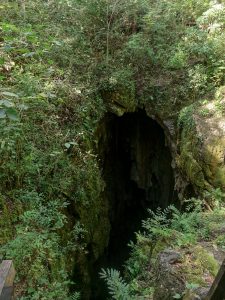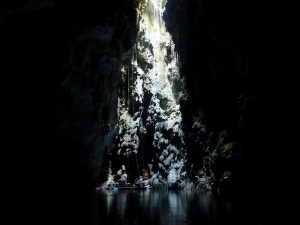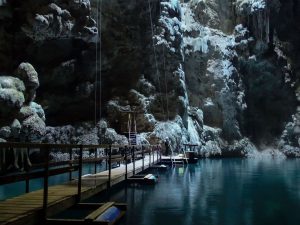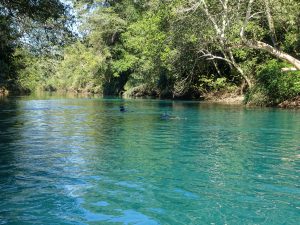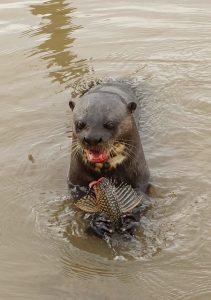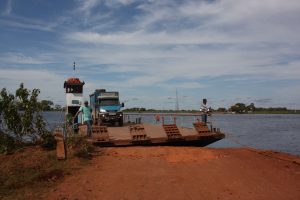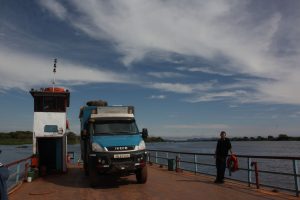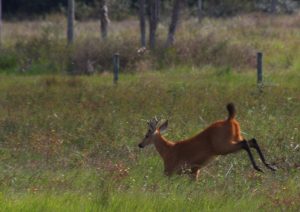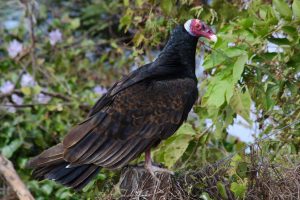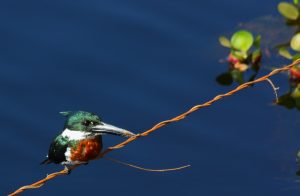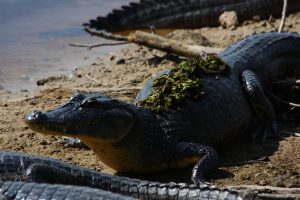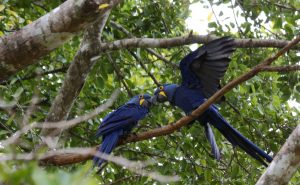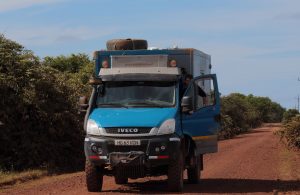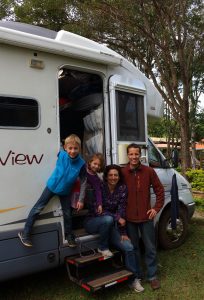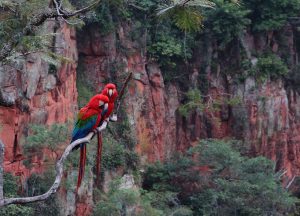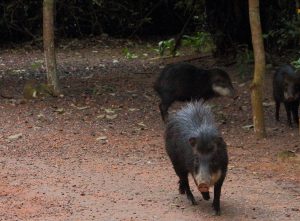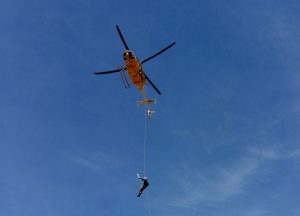It’s Olympic season in Brazil right now. In case it had escaped your attention, Río de Janeiro is hosting the 2016 summer Olympics and Paralympics. We don’t have tickets for any events, but in the ‘eco-tourism’ town of Bonito we managed to partake in the celebrations in a teeny way (route map). Oh, and we did some abseiling too! Read on…
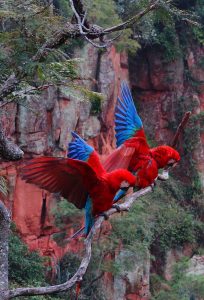
Pigs and Parrots
We started our Bonito adventures with a gentle morning wander in the woods. A sign warned us not to approach the aggressive wild pigs (ok… sound advice), but omitted to mention what to do if they approach you! Just down the path, a small herd (I’m guessing at this one, what’s the collective noun for wild pigs?) of nine or ten wild pigs ran out of the bush and stopped in front of us. The larger ones immediately turned on us in a stand-off. The hair on their backs raised vertically, they flashed their fangs and made weird, loud, cracking sounds from their mouths. We backed away against a small building, but the pigs spread-out in a well-rehearsed pincer-movement, cutting off either end of our escape route! Some of them looked pretty fierce and clearly weren’t happy with our presence! All attempts to brave-up to them, stamping and ‘shoo-ing’ them away proved futile as they closed in on us, forcing us back into a corner. Just as we were getting rather limited in our defensive options, some of the smaller pigs on the right-flank lost interest in the offensive and wandered away AWOL, leaving a small gap in the line of attack. We seized the opportunity and made our Great Escape around the back of the building. Phew! We shuffled-off down the track, back to Cuthbert for a good laugh! They could have taken some serious chunks out of our legs, but they would have been very tasty on the BBQ!
Pig adventure over, we went down the road to visit a huge sink-hole, over 100m deep with a resident colony of parrots and macaws. With their beaks they chip-out holes in the rock-face to build their nests, and the tell-tale sign of a nest location is a substantial dribble of white pooh running down the red cliff-face 😛 ! The birds are stunningly colourful. They pair for life and each couple is so synchronised that when they take flight, they spread their wings and take to the air in perfectly timed coordination. Beautiful.
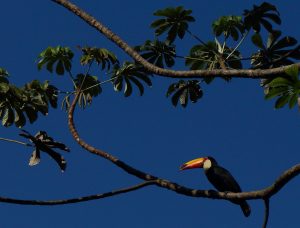
Rio do Prata
Next mission in Bonito was snorkelling with tropical river fish. We are still travelling with our Swiss friends Oliver and Jeannine who have a Bremach camper-truck (similar to Cuthbert) and have coincidentally planned a similar route to us in Brazil, so the four of us booked to snorkel down a tributary to join the main Río do Prata.
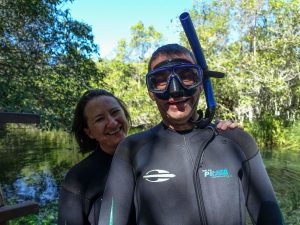
Are the fish ready for this? 🙂 *
All the activities around Bonito have to be booked with a local guide. This seems slightly tedious, but it creates employment and also allows rules to be tightly enforced protecting the delicate environment. The prices are not cheap but everything is professionally run with knowledgeable guides, good quality equipment and safety standards. It’s all rather impressive and easy to see where the tourist-buck is spent. For the snorkelling we were issued ‘shorty’ wet-suits as the water was a bit nippy, but the sparkling blue colour, the abundant fish and the crystal-clear visibility were astonishing.
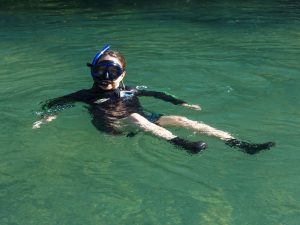
Rio do Prata *
On the trip we were teamed with a group of four young Brazilian ladies. From their loud squeals of glee following us all the way to the river, we gathered that they had not snorkelled before and were rather excited at the prospect… So excited in fact, that not even the water stopped their ‘inter-snorkel shriek-communications’ with each other as they continued underwater! Slightly bizarre, but this actually sums up nicely some of the endearing characteristics of the Brazilian personality: vivacious, excitable and friendly. Luckily there were so many fish that even the girly squeals couldn’t scare them all away, but the experience left us very relieved to have made it here before the Brazilian school holiday crowds arrive in July.
Britain Decides
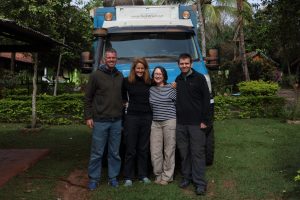
With Oliver & Jeannine
Have we mentioned in the blog before, how many Swiss travellers we have met on the road? We wonder who exactly is left manning Switzerland right now; at least half the population seems to be travelling here in trucks 🙂 Back in Santa Cruz, Bolivia we met Swiss couple Sebastian and Andrea travelling with their two children and were pleased to bump into them again in Bonito. Parked up with them and with Oliver and Jeannine for a few nights, we were grateful for their collective detached and neutral stance over the embarrassing spectacle that is UK’s EU Referendum. Referendum Night was spent with a few glasses of wine and congenial Swiss company, following from afar the extraordinary events unravelling at home. Regardless of which side of the fence one sits, the conduct of this debacle by our politicians has been nothing short of a national embarrassment. We have not yet since the vote, had the misfortune to bump into any travellers from other EU states; but when we do, we can justifiably expect some ridicule about the mess (and let’s not even get started on the shameful spectacle of the England football team losing to Iceland in Euro 2016 🙁 ) .
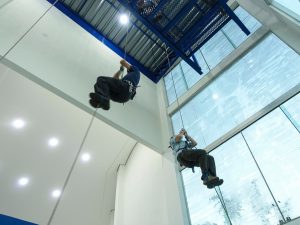
Abseil training *
Moving on from politics… we headed with Oliver and Jeannine to Phase 1 of our next adventure: Abismo Anhumas. For this we had signed-up to abseil 72 metres down into an underground cavern, then scuba-dive/snorkel around the cave lake before climbing back up the rope to the surface. Gulp!
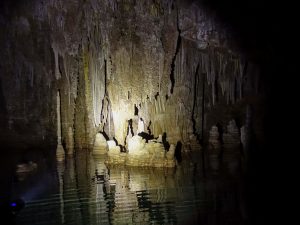
In the Abismo *
Phase 1 is a training session in town, then next day Phase 2: the Abyss! At the surface, the Abismo is a small hole only a few metres wide, opening vertically downwards. We stood and looked down into the looming darkness: a tunnel of black with two ropes dangling down into the depths. We’re told that the hole leads to a vast and beautiful underground cavern. Hmmm… I guess we’ll just have to trust them on that! Our training had been on a 10 metre high rig in a well-lit building; the ‘real thing’ looked rather different! So all we have to do is harness-up, hook on, and abseil down, two by two! Right then. Here goes. Marcus and I drop first.
After the first 6 metres of drop, the rock walls of the narrow cave opened out and we emerged into the vast cavern space for a further 66 metre drop in free-space. The small opening above us didn’t let much light into the cave below, but as we descended and our eyes adjusted to the darkness, the view of the cave started to take shape around us. It was difficult to take it all in whilst focussing on abseiling down the rope, but we saw the glassy silver plate of the perfectly still water below us. Awesome shadows started to emerge of enormous formations of stalactites and stalagmites.
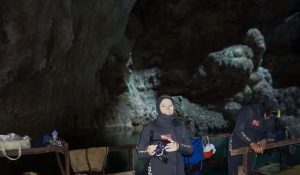
Full-monty wetsuit needed here, even for snorkelling! *
As advertised, an instructor was there to meet us as we reached the pontoon floating on the cave lake at the bottom. Phew! ‘Easy peasy lemon squeezy’ this abseiling lark! 🙂 Then we looked up at the 72 meters of rope leading up to the tiny hole above us. Hmmm… getting back up may be a little trickier, but we’ll worry about that when we come to it 🙂
First, the instructor paddled us around the cave lake in a small rubber dinghy. By torch-light she highlighted all the amazing formations of the cave: truly gob-smacking how many years it had been there, undetected. The cave was only discovered in 1984; scientists then spent 11 years studying it before opening to the public. The difficult access means that only relatively few visitors ever get to see this marvel and as a result it does feel very special. It’s great that the cave has not been developed, but the lack of light does make it difficult to photograph.
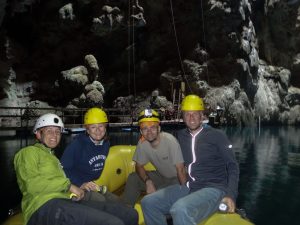
Cave dinghy *
Climbing from the dinghy back onto the pontoon, it is now time to see the underwater world! Full-body wet suits are required here, with hood, the lot! Marcus, Oliver and Jeannine are all qualified scuba-divers and could get down amongst the deep stalagmites. I’m limited to snorkelling around above the divers, but the water is so clear that I could swim and watch from above the divers’ torches highlighting the underwater formations.
The underwater stuff was amazing, but now we have to tackle the 72m climb out of the cave. The technique is basically the opposite of abseiling: we hang off the rope in a harness, then haul ourselves on a ratchet slider, bit by bit all the way up the rope to the top. Marcus and I go first, side by side, bouncing in mid-air with the stretch in our ropes and occasionally spinning as there is no rock-face to hold steady. Needless to say, the ascent took rather longer than the abseil down, but it’s still great fun and we were able to enjoy the view again back down into the cave as we climbed out. Marvellous day 🙂
The Torch
Next day… a bit of Olympic magic comes to Bonito! When we tried on-line to get tickets for the Olympic events in August, the only availability was for Greco-Roman Wrestling. Greco-what???? No offence to the Greco-Roman athletes, but we think we’ll give that a miss. So it was lucky then, that the town of Bonito has come to the rescue with a small compensatory Olympic experience for us: an Olympic Torch Run.
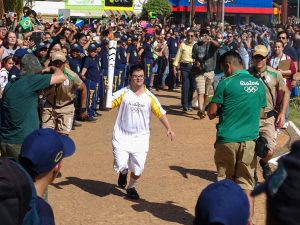
Torch Boy *
In the town square the crowds gathered to wait… and wait. The anticipation was rising and around an hour later than advertised, a helicopter arrived overhead, yes… that’s directly overhead the crowd. No clear safety area below. What could possibly go wrong??? Well, the Olympic Torch Runs are not having a great safety record so far in Brazil; in Manaus a few days ago a paraded jaguar escaped into the crowd and had to be shot by police! Anyway, here in Bonito the hovering helicopter dropped a rope on which the torch deliverer was meant to abseil down. Unfortunately, the rope didn’t deploy properly and the helicopter had to fly away to sort it out. Twenty minutes later the helicopter returned, the rope was successfully dropped and a soldier abseiled down to hand the Olympic Torch to a young lad who had been waiting in his shiny white Olympic outfit for a couple of hours. The crowd went mad! Anyone would think Tom Cruise had come to town! Sadly this is not the case. If it were, then I would have been there chasing with them 🙂
Swamp Theory
After a week in Bonito with lots of excitement, abseiling and torches, we finally dragged ourselves away to head via the southern Pantanal back to Bolivia. We said farewell to the lovely Jeannine and Oliver who have been great travel companions through our time in Brazil. We have had some great laughs together and will certainly be staying in touch with them in future.
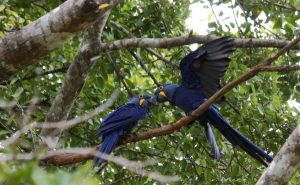 So… the southern Pantanal. Remember when we first arrived in Brazil we sampled the ‘north swamp’? Well now we’re keen to investigate the Scientific Swamp Theory: is ‘a swamp’ necessarily ‘a swamp’? Are all swamps created equal? Is it fair and reasonable to discriminate between northern and southern swamps? One can’t make assumptions with these things you know. They need to be scientifically verified (click here for the North Pantanal blog).
So… the southern Pantanal. Remember when we first arrived in Brazil we sampled the ‘north swamp’? Well now we’re keen to investigate the Scientific Swamp Theory: is ‘a swamp’ necessarily ‘a swamp’? Are all swamps created equal? Is it fair and reasonable to discriminate between northern and southern swamps? One can’t make assumptions with these things you know. They need to be scientifically verified (click here for the North Pantanal blog).
Just a few hours from Bonito, the southern Pantanal route is a lovely drive and on first glance, remarkably similar to the north. We saw much the same wildlife as we had seen in the north. But in reporting our findings, based on (not very) detailed scientific analysis and research, we cannot ignore the fact that ‘up north’ we had an amazing Jimmy Jaguar encounter, which result was not repeated on tests in the south. The conclusion must therefore be, that although similar, the swamps are not the same and discrimination in favour of the northerly swamp can indeed be justified. Q.E.D. 🙂
Over and Out (for now)
The south Pantanal drive has now ended our loop into western Brazil and brought us back to the Bolivian border. We’ve done around 2,300 km in Brazil and ended up only around 300 km south of where we entered the country three weeks ago. In part 1 of our Brazil Blog we had a stab at an initial impression of the country and thought that by now we might be better placed to offer a more considered view of things here. But we’re not. The more we travel in Brazil, the more of it we need to see to understand what it’s all about! Does that make sense?
It’s huge and we have seen only a tiny corner of it. From this tiny corner, we have found the stereotypical image of the Brazilian characteristics to be fairly accurate: friendly, outgoing and lively. What else? Oh yes, they love their flip-flops! Every supermarket, even small rural stores, has a rack of assorted Havaiannas, needless to say… far cheaper than the rip-off prices charged for the same thing in UK.
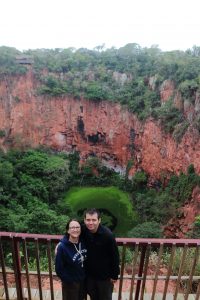 Brazil is a gregarious, 21st century nation with modern cities, some good shopping and tasty food. The country has a few notable political problems that have featured in the world media, but as Brits we’re not exactly well placed to sit in judgement in this respect (words such as: ‘pot’, ‘kettle’ and ‘black’ could justifiably be thrown in our faces). Political and economic problems aside, we have seen an extremely well-run tourism industry with impressively high standards. Difficulty with the language has hampered our ability to interact with local people, which is a shame and totally our fault. Nevertheless, Brazil has made a very favourable impression on us. We hope at a later stage in our travels, to return to Brazil for a longer time and to see much more; then we will make more effort to learn the language and delve a bit deeper!
Brazil is a gregarious, 21st century nation with modern cities, some good shopping and tasty food. The country has a few notable political problems that have featured in the world media, but as Brits we’re not exactly well placed to sit in judgement in this respect (words such as: ‘pot’, ‘kettle’ and ‘black’ could justifiably be thrown in our faces). Political and economic problems aside, we have seen an extremely well-run tourism industry with impressively high standards. Difficulty with the language has hampered our ability to interact with local people, which is a shame and totally our fault. Nevertheless, Brazil has made a very favourable impression on us. We hope at a later stage in our travels, to return to Brazil for a longer time and to see much more; then we will make more effort to learn the language and delve a bit deeper!
Brazil now sits in the global spotlight as Río puts the finishing touches to its plans for the 2016 Olympics and Paralympics. We wish them all best for this – they certainly love their sport and anyone who comes to see the spectacle is likely to have the party of a lifetime in Río! We will be watching some of it, probably from a bar somewhere… but p’raps not all that Greco-Roman-Stuff 🙂
Link to next blog: Back to Bolivia Link to full South America Blog
Caves and Torches Gallery
- Torch Boy *
- Cave dinghy *
- With Oliver & Jeannine
- In the Abismo *
- Abseil training
- Full-monty wetsuit needed here, even for snorkelling! *
- Rio do Prata *
(* photos – thanks to Oliver Reinhard)

